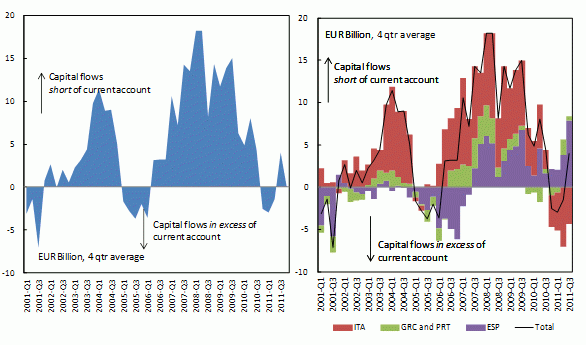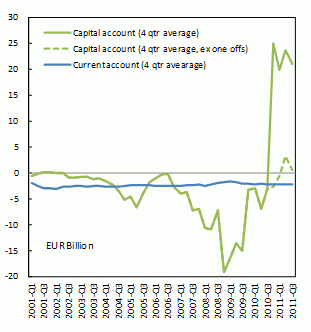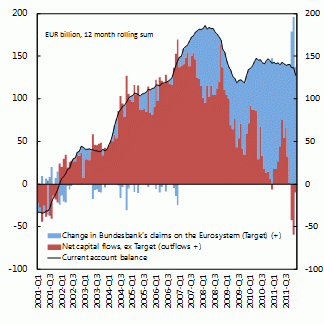There is a fierce ongoing debate over the so-called TARGET claims in the Eurozone. TARGET balances are the mechanism through which national central banks within the Eurosystem lend to each other. TARGET positions are intended to smooth over temporary liquidity needs of the member countries and the system is typically close to balanced. Since 2007, however, imbalances have grown steadily and as of this writing Germany has a large creditor position, while a number of countries have become net debtors (Figure 1). The sources of these imbalances and their implications have been the subject of a lively and at times contentious debate. Sinn (2011) and Sinn and Wollmershaeuser (2011) have raised the concern that these imbalances represent a quasi-fiscal action by the creditor central banks in favour of the debtors.
Figure 1. TARGET balances of selected European economies (December 2011)
Source: IFS, National Central Banks and own calculations. Note: For Ireland data for October, for Green data for November.
Some of the concerns have proven unfounded. It is not the case that the claims from the Bundesbank on the Eurosystem will reach a limit, as Tornell and Westermann (2011) fear, since the balance sheet of the Bundesbank can expand along with the accumulation of liquidity by the German banking system. Likewise, Whelan (2011) and Bindseil and Koenig (2011) argue correctly that the German creditor position does not imply that German firms and banks are being starved of funds. In any event, restricting TARGET imbalances would be incompatible with a monetary union (Jobst 2011).
Missing in the debate is a careful discussion of what these TARGET positions are financing. Attention has focused principally on the current-account financing needs of Eurozone countries. The implication of this focus is that regaining TARGET system balance will require further reduction in the current-account deficits – especially of countries facing market scrutiny and elevated interest rates. However, a more important development in Europe has been the reversal of capital flows, which has created new financing pressures. The TARGET system has been the vent to deal with these pressures. In this column, we use Germany’s bilateral balances with European partners to clarify these developments.1
German current- and capital-account dynamics
Although the Eurozone current-account differences receive considerable attention, much action within Europe occurs on the capital account.2 Of special interest, German financial flows have traditionally been more volatile than trade flows. For example, Germany’s current-account surplus with select economies – Greece, Italy, Portugal, and Spain – has been much smoother than the capital-account balances with these same economies (Figure 2).3 Moreover, bilateral current and capital accounts need not be balanced and, in fact, there is almost no correlation between these two balances, implying that bilateral trade in goods and services has had only a limited influence on bilateral cross-border capital flows, and these balances have marched to different tunes. In other words, financial flows have been unrelated to current-account financing, and have reflected portfolio investment and interbank operations.
Figure 2. Current and capital account of Germany with Greece, Italy, Portugal, and Spain
Post-crisis, the contraction of domestic demand in the financially stressed countries has reduced their combined current-account deficit with Germany by about half from its peak in 2008 back to levels observed in 2004. However, the variation in the capital account has been three times larger and now German private capital has actually been retrenching.
In 2005 and 2006, Spain received larger capital flows from Germany than needed to finance the current-account deficit with Germany (Figure 3), as did Ireland, which is discussed in more detail below. For Greece and Portugal, this phenomenon lasted for a shorter period. But in each instance, already before the Eurozone crisis intensified, the capital account had tended to reverse course. With Spain, for example, financing flows fell short of the current-account balance after 2007. The same was true for Greece and Portugal. An exception has been Italy, where capital flows from Germany have typically been less than the Italian current-account deficit vis-à-vis Germany and where net capital flows from Germany picked up in 2011, at least until the last available observation in the third quarter of 2011.
Figure 3. Germany’s current account net of capital outflows from Germany: Greece, Italy, Portugal, and Spain
Ireland is a special case. Germany’s current-account balance with Ireland has traditionally been negative (implying net flows of goods and services from Ireland to Germany) and has not moved much over the past decade. Financial transactions, on the other hand, have far outweighed the current-account transactions due to the size of the Irish-German banking sector. As many as ten German banks have an operating licence in the International Financial Centre located in Ireland. Net capital flows from Germany to Ireland increased sharply between 2006 and late 2008 (Figure 4). However, the reversal, starting in early 2009, was equally sharp. Large one-off transactions in the last quarter of 2010 pushed the capital account into positive territory (implying net financial flows into Germany). But even absent these transactions, net capital flows to Ireland would be around zero today.
Figure 4. Current and capital account of Germany with Ireland
In sum, the German capital flows to the stressed Eurozone economies have moved from an average of €20 billion per quarter at end 2008 to near zero in mid-2011 without the one-off transactions with Ireland (and more starkly, with that transaction, there was a net average inflow into Germany of €15 billion in the second and third quarters of 2011). The current account, while it fell by 50%, has only moved by €6.5 billion. Thus trade imbalances have decreased but the reversal of capital flows has been much more significant.
The broader point is that the focus on current-account imbalances within Europe has distracted from the more dramatic evolution on the capital account. Pre-crisis, the overall German current and capital accounts were largely balanced, as would normally be expected. Since 2008, an unusual situation has arisen. The current-account surplus has shrunk, falling sharply also with European trading partners and thus contributing to a partial correction in Eurozone imbalances. However, an offsetting and more significant development has been a reversal of capital flows within Europe. Germany, though still enjoying a current-account surplus with the world (and with other European economies), has become a net recipient of capital from the world (Figure 5), especially from the financially-distressed economies in Europe. Absent filling this gap via TARGET, the adjustment would have been considerably more wrenching, with potentially widespread bank failures.
Figure 5. Current account, capital account, and change in TARGET claims for Germany
The TARGET balances and the capital account
The change in Bundesbank’s TARGET claims has had a strong negative correlation with the capital flows to the countries under stress (Figure 6). In contrast, there is little relationship between the change in TARGET claims and the current-account balance with these countries. In other words, the TARGET mechanism has apparently balanced the flows on the capital account. Only this time around, the size of the TARGET financing is much larger and potentially more persistent. German investment positions in the rest of Europe are being unwound but private funds are not easily available to finance these payments. As such, banks in stressed economies are turning to their central banks, who in turn obtain liquidity through the system of interconnected European national central banks. In contrast, German banks enjoy greater liquidity, which they are unwilling to use either for direct financing of trade or in the interbank market presumably because of a heightened perception of credit risks. This excess liquidity is being channelled back into the Eurosystem through the Bundesbank, which is, therefore, a large creditor.
Figure 6. Change in Bundesbank's TARGET claims, capital and current account of Germany vis-a-vis Greece, Ireland, Italy, Portugal and Spain
The TARGET imbalances are thus a symptom of differential liquidity and funding conditions across the Eurozone banking system. The Eurozone has used the TARGET mechanism to deal with the major shift in the direction of capital flows. This has been an important achievement. However, the TARGET system is intended to deal with liquidity needs and is, therefore, expected to be in balance except over short periods. The return to balance on this occasion will likely be longer and will require adjustments that go beyond traditional demand management policies to reduce current-account deficits. At stake here is the entire financial architecture of the Eurozone.
Disclaimer: The views expressed here are those of the authors and should not be attributed to the IMF, its Executive Board, or its management.
References
Bindseil, Ulrich, and Philipp Johann Koenig (2011), “The economics of TARGET2 balances”, SFB 649 Discussion paper Nr. 2011-035
Borio, Claudio and Piti Disyatat (2011), "Global imbalances and the financial crisis: Link or no link?", BIS Working Paper 346.
Jobst, Clemens (2011), “A balance sheet view on TARGET – and why restrictions on TARGET would have hit Germany first”, VoxEU.org, 19 June.
Shin, Hyun Song (2011), “Global savings glut or global banking glut?”, VoxEU.org, 20 December.
Sinn, Hans-Werner (2011), “The ECB’s stealth bailout”, VoxEU.org, 1 June.
Sinn, Hans-Werner and Timo Wollmershaeuser (2011), "TARGET Loans, Current Account Balances and Capital Flows: The ECB’s Rescue Facility", NBER Working Papers 17626.
Tornell, Aaron and Frank Westermann (2011), “Eurozone Crisis, Act Two: Has the Bundesbank reached its limit?”, VoxEU.org, 6 December.
Whelan, Karl (2011), “Professor Sinn misses the TARGET”, VoxEU.org, 9 June.
1 Bilateral current and capital-account data for Germany with selected trading partners is available from the Bundesbank’s website. Bilateral capital-account data may give an incomplete picture of capital flows if financial transactions involve third countries.
2 This action occurs mainly through banking sector flows (Shin 2011 and Borio and Disyatat 2011).
3 The bilateral accounts do not include changes in TARGET claims.








